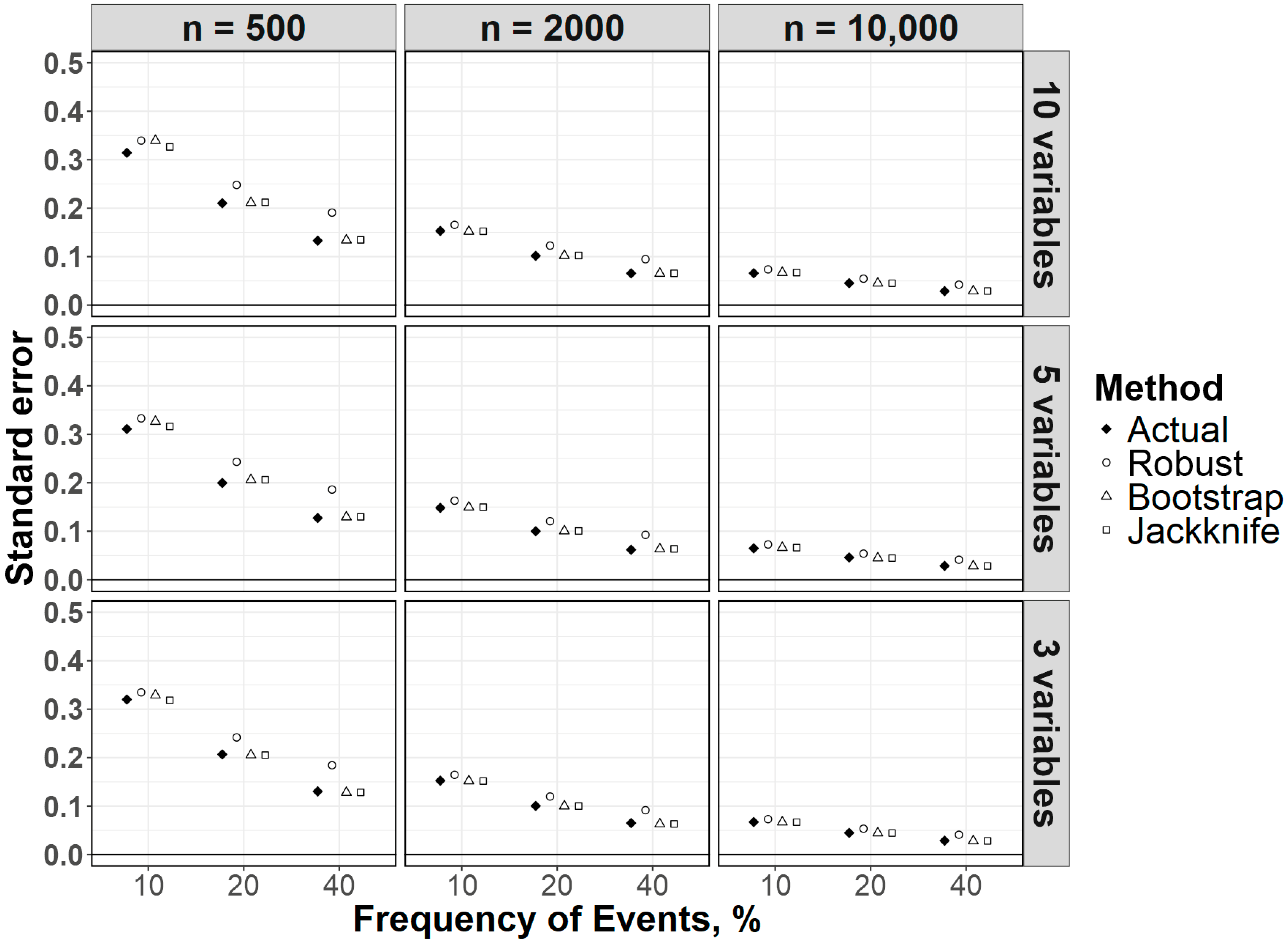Confidence Intervals of Risk Ratios for the Augmented Logistic Regression with Pseudo-Observations
Abstract
1. Introduction
2. Materials and Methods
2.1. The Augmented Logistic Regression
| Algorithm 1 Augmented logistic regression |
|
2.2. Variance Estimation and Confidence Intervals
2.2.1. Bootstrapping Approach
| Algorithm 2 Bootstrap-based variance estimator |
|
2.2.2. Jackknife Approach
| Algorithm 3 Jackknife-based variance estimator |
|
| . |
3. Results
3.1. Simulations
3.2. Applications
4. Discussion and Conclusions
Supplementary Materials
Author Contributions
Funding
Institutional Review Board Statement
Informed Consent Statement
Data Availability Statement
Conflicts of Interest
References
- Greenland, S. Interpretation and choice of effect measures in epidemiologic analyses. Am. J. Epidemiol. 1987, 125, 761–768. [Google Scholar] [CrossRef] [PubMed]
- McNutt, L.-A.; Wu, C.; Xue, X.; Hafner, J.P. Estimating the relative risk in cohort studies and clinical trials of common outcomes. Am. J. Epidemiol. 2003, 157, 940–943. [Google Scholar] [CrossRef] [PubMed]
- Harrington, D.; D’Agostino, R.B., Sr.; Gatsonis, C.; Hogan, J.W.; Hunter, D.J.; Normand, S.-L.T.; Drazen, J.M.; Hamel, M.B. New guidelines for statistical reporting in the journal. N. Engl. J. Med. 2019, 381, 285–286. [Google Scholar] [CrossRef] [PubMed]
- Zou, G. A modified poisson regression approach to prospective studies with binary data. Am. J. Epidemiol. 2004, 159, 702–706. [Google Scholar] [CrossRef] [PubMed]
- Cheung, Y.B. A modified least-squares regression approach to the estimation of risk difference. Am. J. Epidemiol. 2007, 166, 1337–1344. [Google Scholar] [CrossRef] [PubMed]
- Noma, H.; Gosho, M. Finite-sample improved confidence intervals based on the estimating equation theory for the modified poisson and least-squares regressions. Epidemiol. Methods 2025, 14, 20240030. [Google Scholar] [CrossRef]
- Diaz-Quijano, F.A. A simple method for estimating relative risk using logistic regression. BMC Med. Res. Methodol. 2012, 12, 14. [Google Scholar] [CrossRef] [PubMed]
- Schouten, E.G.; Dekker, J.M.; Kok, F.J.; Le Cessie, S.; Van Houwelingen, H.C.; Pool, J.; Vanderbroucke, J.P. Risk ratio and rate ratio estimation in case-cohort designs: Hypertension and cardiovascular mortality. Stat. Med. 1993, 12, 1733–1745. [Google Scholar] [CrossRef] [PubMed]
- Wacholder, S. Binomial regression in GLIM: Estimating risk ratios and risk differences. Am. J. Epidemiol. 1986, 123, 174–184. [Google Scholar] [CrossRef] [PubMed]
- Wallenstein, S.; Bodian, C. Inferences on odds ratios, relative risks, and risk differences based on standard regression programs. Am. J. Epidemiol. 1987, 126, 346–355. [Google Scholar] [CrossRef] [PubMed]
- Dwivedi, A.K.; Mallawaarachchi, I.; Lee, S.; Tarwater, P. Methods for estimating relative risk in studies of common binary outcomes. J. Appl. Stat. 2014, 41, 484–500. [Google Scholar] [CrossRef]
- White, H. Maximum likelihood estimation of misspecified models. Econometrica 1982, 50, 1–25. [Google Scholar] [CrossRef]
- Prentice, R.L. A case-cohort design for epidemiologic cohort studies and disease prevention trials. Biometrika 1986, 73, 1–11. [Google Scholar] [CrossRef]
- Noma, H. Variance estimation for logistic regression in case-cohort studies. J. Epidemiol. 2024, 34, 38–40. [Google Scholar] [CrossRef] [PubMed]
- Battistin, E.; Sianesi, B. Misclassified treatment status and treatment effects: An application to returns to education in the United Kingdom. Rev. Econ. Stat. 2011, 93, 495–509. [Google Scholar] [CrossRef]
- Efron, B. Nonparametric standard errors and confidence intervals. Can. J. Stat. 1981, 9, 139–158. [Google Scholar] [CrossRef]
- Efron, B. The Jackknife, the Bootstrap and Other Resampling Plans; Society for Industrial and Applied Mathematics: Philadelphia, PA, USA, 1982. [Google Scholar]
- Efron, B. Better bootstrap confidence intervals. J. Am. Stat. Assoc. 1987, 82, 171. [Google Scholar] [CrossRef]
- Efron, B. Jackknife-after-bootstrap standard errors and influence functions. J. R. Stat. Soc. Ser. B. 1992, 54, 83–111. [Google Scholar] [CrossRef]
- Miller, R.G. The jackknife—A review. Biometrika 1974, 61, 1–15. [Google Scholar]
- Efron, B.; Stein, C. The jackknife estimate of variance. Ann. Stat. 1981, 9, 586–596. [Google Scholar] [CrossRef]



| 95% Confidence Interval | ||||
|---|---|---|---|---|
| Method | Estimate | SE | Lower | Upper |
| Robust variance | 1.836 | 0.157 | 1.552 | 2.172 |
| Bootstrap (Percentile method) | 1.836 | 0.111 | 1.629 | 2.072 |
| Bootstrap (BCa method) | 1.836 | 0.111 | 1.631 | 2.073 |
| Jackknife approach | 1.836 | 0.114 | 1.625 | 2.074 |
Disclaimer/Publisher’s Note: The statements, opinions and data contained in all publications are solely those of the individual author(s) and contributor(s) and not of MDPI and/or the editor(s). MDPI and/or the editor(s) disclaim responsibility for any injury to people or property resulting from any ideas, methods, instructions or products referred to in the content. |
© 2025 by the authors. Licensee MDPI, Basel, Switzerland. This article is an open access article distributed under the terms and conditions of the Creative Commons Attribution (CC BY) license (https://creativecommons.org/licenses/by/4.0/).
Share and Cite
Shiiba, H.; Noma, H. Confidence Intervals of Risk Ratios for the Augmented Logistic Regression with Pseudo-Observations. Stats 2025, 8, 83. https://doi.org/10.3390/stats8030083
Shiiba H, Noma H. Confidence Intervals of Risk Ratios for the Augmented Logistic Regression with Pseudo-Observations. Stats. 2025; 8(3):83. https://doi.org/10.3390/stats8030083
Chicago/Turabian StyleShiiba, Hiroyuki, and Hisashi Noma. 2025. "Confidence Intervals of Risk Ratios for the Augmented Logistic Regression with Pseudo-Observations" Stats 8, no. 3: 83. https://doi.org/10.3390/stats8030083
APA StyleShiiba, H., & Noma, H. (2025). Confidence Intervals of Risk Ratios for the Augmented Logistic Regression with Pseudo-Observations. Stats, 8(3), 83. https://doi.org/10.3390/stats8030083






